Environment: milieu / climate zone / depth range / distribution range
Ecologia
marinhas batipelágico; intervalo de profundidade 298 - 4938 m (Ref. 58302), usually 400 - 2400 m (Ref. 58302). Deep-water; 64°N - 20°N, 105°E - 130°W
North Pacific: temperate and subtropical, from southern Japan to Baja California, from 21°N and into the Bering Sea.
Tamanho / Peso / Idade
Maturity: Lm ? range ? - ? cm
Max length : 6.2 cm SL macho/indeterminado; (Ref. 559)
Descrição suscinta
Chaves de identificação | Morfologia | Morfometria
Espinhos dorsais (total) : 0; Raios dorsais (total) : 12 - 15; Espinhos anais: 0; Raios anais : 17 - 20; Vértebras: 31 - 33. Body dark-brown or black; margin of scale pockets especially dark; area immediately anterior to anal origin densely pigmented and not transparent; peritoneum black, ending above area between 3rd and 4th VAV, usually invisible from the outside (Ref. 559). Gill lamellae free and reduced (Ref. 559).
Meso- to bathypelagic (Ref. 58302). Inhabits deep water and is only captured with special equipment. Lipid content is 4.0 % in fresh body weight and wax ester is 58.4 % in total lipid (Ref. 9193). Protandrous hermaphrodite, oviparous with planktonic eggs and larvae (Ref. 35800).
Ciclo de vida ou comportamento de acasalamento
Maturities | Reprodução | Spawnings | Egg(s) | Fecundities | Larvas
Masuda, H., K. Amaoka, C. Araga, T. Uyeno and T. Yoshino, 1984. The fishes of the Japanese Archipelago. Vol. 1. Tokai University Press, Tokyo, Japan. 437 p. (text). (Ref. 559)
Status na Lista Vermelha da UICN (Ref. 130435)
Ameaça para os humanos
Harmless
Uso pelos humanos
Ferramentas
Relatórios especiais
Baixar XML
Fontes da internet
Estimates based on models
Preferred temperature (Ref.
123201): 1.7 - 7.3, mean 2.4 °C (based on 579 cells).
Índice de diversidade filogenética (Ref.
82804): PD
50 = 0.5001 [Uniqueness, from 0.5 = low to 2.0 = high].
Bayesian length-weight: a=0.00389 (0.00171 - 0.00885), b=2.99 (2.79 - 3.19), in cm total length, based on LWR estimates for this (Sub)family-body shape (Ref.
93245).
Nível Trófico (Ref.
69278): 3.1 ±0.3 se; based on size and trophs of closest relatives
Resiliência (Ref.
120179): Elevada, tempo mínimo de duplicação da população menor que 15 meses (Preliminary K or Fecundity.).
Fishing Vulnerability (Ref.
59153): Low vulnerability (10 of 100).
